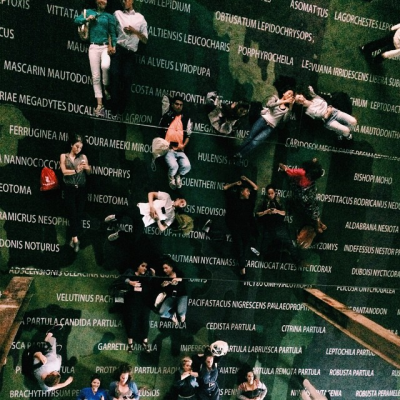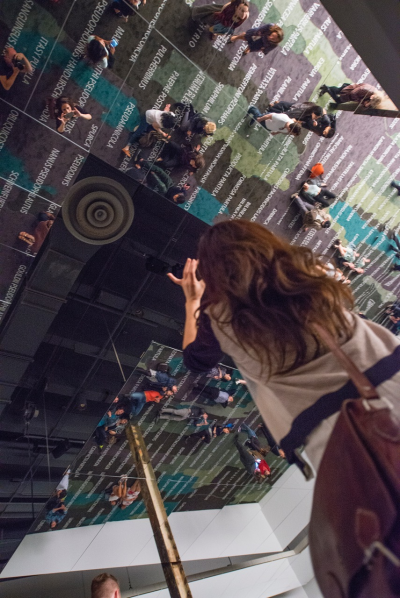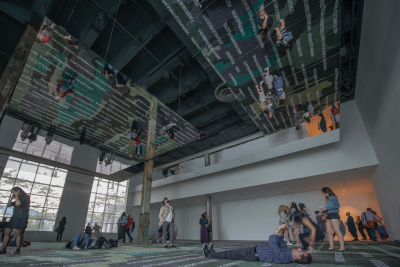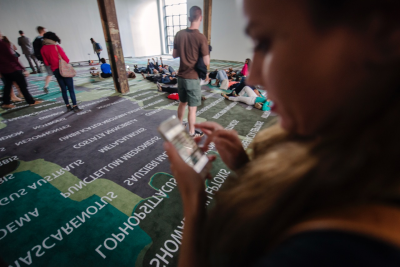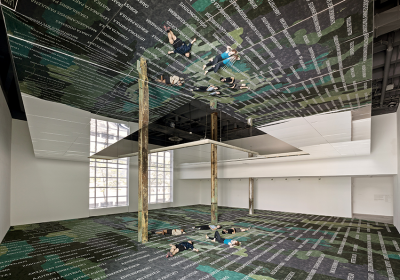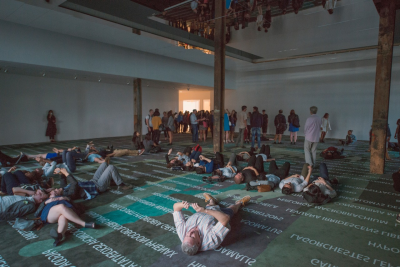
Eminent Domain
The Powerplant
Toronto
20 June - 7 September, 2015
Eminent DomainEminent Domain continues Bik Van der Pol's investigation on the ways that human activity in the globalized age has a direct effect on (ecological) systems. The title references the concept coined by author Hugo Grotius in 1625. Eminent domain is understood as the power that the State may exercise over land within its territory, whereby the government or one of its agencies has the right to expropriate private property for public use through payment or compensation. By foregrounding this concept, Bik Van der Pol’s project alludes to the increasing privatization of previously public goods including territory, property and the public domain at large.
Using mirrored panels that follow the architecture of the space and reflect the texts woven into the carpet on the floor, Bik Van der Pol have conceived of an environment in the gallery that makes it possible to grasp the overwhelming collection of data related to ecology and species extinction figures. These data are derived from the IUCN Red List of Threatened Species, more specifically the archived list of extinct species as counted from the year 1500.
Bik van der Pol collaborated with soundscape ecologist Dr. Bernie Krause, who contributes to the installation with a selection of sounds from his archive, more specifically those produced in the 1990s in previously healthy habitats in Borneo, Costa Rica, Sumatra and Zimbabwe.
Since their original recordings, each of these habitats has changed drastically as a direct result of human intervention and natural disasters.1) Krause’s soundscapes coupled with figures affected by ecological changes results in a project that moves collections of data from abstraction to experience. By physically situating and mirroring the viewers amidst these statistics, they shift from spectator to immersed participant.
During the exhibition, the space is regularly used as a site for discursive activities that examine both the re-articulation of public and private property and the threat of such activities on natural environments: No Reading After the Internet, by Cheyanne Turions and Extraction Empire, program of short films curated by artist Charles Stankievech
1) Main voices from soundscape audio field recordings are:
Borneo (15 min.) Gibbons, cicadas, crickets, frogs, brown barbet, hornbill, squirrel, ashy tailorbird. Costa Rica (15 min.) Tinamou, tree frog, bats, cicadas, various insects, red-winged parrotlet, parrots, Pacific screech owl, slaty ant-wren, firey-billed aracary, brown howler monkeys, clay-colored robin, white-tipped dove, blue-crowned mot-mot. Sumatra (15 min.) Gibbons, siamang, orang-utan, leaf-monkey, black-browed barbet, lineated barbet, various insects, mustached babbler, white-rumped shama, rhinoceros hornbill, Argus pheasant, Malaysian-eared nightjar. Zimbabwe (15 min.) Baboons, barred owlet, scops owlet, natal francolin, freckled nightjar, cape turtle dove, ground hornbill, Egyptian goose, bearded robin, insects, frogs.

